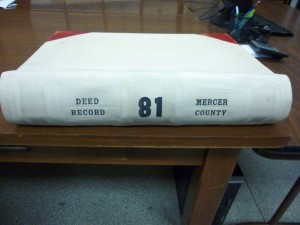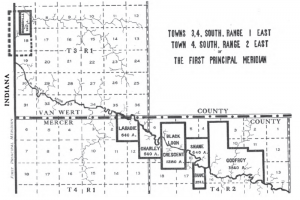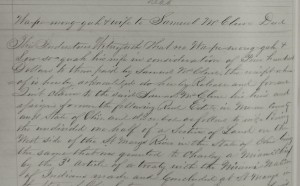Some of my favorite record sources are the deed books at the Recorder’s Office. I enjoy searching through these books which often contain more than just land deeds. And I never know what I might find in them.
I have found wills, affidavits, leases, maps, family relationship information, power of attorney, bills of sale, and other interesting items in the deed books. Information in these records can sometimes prove relationships and may help solve genealogical brick walls.
Recently I have been writing about my great-great-grandfather Friedrich Schinnerer, who once owned a substantial amount of land and a grist mill in northern Mercer County, Ohio, near what is now Rockford, in Dublin Township.
While looking through the Dublin and Black Creek Township Deed books I noticed the name Schumm on some of the documents. That got my attention. I usually think of the Schumms owning land and living in Van Wert County, near the settlement named after them, but a few Schumms owned land across the county line, in Mercer County, near Schinnerer’s land.
The documents I found were sworn affidavits by Jacob Schumm, who attested to some family information well as information about another family that I was not expecting to find. A Miami Indian family!
The Shanesville area [now known as Rockford] is rich in Indian history and I should not have been surprised to see an Indian family mentioned in some records.
Shanesville began as an old Indian trading post, before the War of 1812, located half way between Piqua and Fort Wayne. It was run by a French-Indian known as Anthony Madore, who died in 1815. Anthony Shane, a half-bred Indian and scout for General Anthony Wayne’s army, was given a grant of 640 acres north of town and 320 at the town site. He and his wife lived in a cabin north of town until 1832.
Shanesville was named after Anthony Shane but the post office was called Shane’s Crossing. Shanesville was the first town laid out in Mercer County and was the first seat of justice there. [1]
At one time there were six Indian reserves in the area around Shanesville and the sections are still known by their reserve names to this day–Labadie, Charley, Black Loon, Crescent, Shane, and Godfroy Reserves. Labadie Reserve and part of Charley Reserve are in Black Creek Township. Friedrich Schinnerer and some Schumms owned land that was once part of this Indian reserve land.
The Treaty of St. Mary’s (aka Treaty with the Miami, 1818) was signed on October 6, 1818, at St. Mary’s, Ohio, between representatives of the United States government, the Miami Tribe of Indians, and others living in their territory. The treaty contained seven articles and Article III created the reserves in the Shanesville area. Based on the terms of the treaty, the Miami ceded much of their land, while the United States granted them the reserves, agreed to pay the Miami a perpetual annuity of fifteen thousand dollars, was to construct one gristmill and one sawmill, to provide one blacksmith, one gunsmith, agricultural implements, and provide the Miami Indians with 160 bushels of salt annually. [2]
The Miami was the largest Indian tribe in the state. Most of the Indians starting leaving the area in the 1830s but those that owned property were permitted to remain on their land, under the Treaty of St. Marys. [3]
So how do the Jacob Schumm affidavits I found at the Recorder’s Office fit in?
Jacob Schumm was actually Jacob Frederick Schumm (1839-1927), son of immigrants George Martin and Maria (Pflueger) Schumm.
In October 1911, Jacob Schumm swore before a Notary Public at Mercer County, Ohio, that he was 73 years of age and had resided in Mercer County, Ohio, for the past 73 years; that he was the son of George Schumm, late of Whitley county of Indiana and a nephew of Frederick Schumm late of said county, who purchased one entire section of land from Samuel McClure on 15 September 1860. That section was known as Charley Reservation, located in Blackcreek and Dublin Townships. [4]
Charley was Chief of the Miami Tribe of Indians, who was granted 640 acres of land, known as the Charley Reserve, by Article III of the Treaty of St. Marys in 1818. The Charley Reserve lies between two other reserves. The Peter Labadie Reserve is to the west, the Crescent Reserve is to the east, and the St. Marys River borders the north end.
To the best of Jacob Schumm’s knowledge, Chief Charley died in Whitley, Indiana, about 1838, still owning the Charley Reserve land. And, to the best of Jacob’s knowledge, from conversations with his father and uncle, Charley’s widow and two children were his only legal representatives and heirs at law.
Jacob did not remember the names of Charley’s heirs or the name of Charley’s widow, except by referencing the deeds. The deeds were referenced in the affidavit:
On 14 August 1851, Sho-pe-quah [Charley’s wife] and Kil-so-Quah [Charley’s daughter], of Huntington, Indiana, sold the section of land granted to Charley in 1818 to Samuel McClure for $820, as recorded in Vol. Q page 210. The deed indicates that Charley was deceased and that Kil-so-Quah was his only surviving heir at law. On 7 July 1860 Charley’s son Wa-pe-mong-Quah sold his undivided half section of land, the land that was granted to his father in 1818, to Samuel McClure for $400, as recorded in Vol. 2 page 230. That deed also mentions Wa-pe-mong-Quah’s wife, Low-so-Quah.
After examining the old deeds Jacob was satisfied that Sho-pe-Quah was the widow of Charley and that Kil-so-Quah was a daughter and Wa-Pe-mong-Quah was a son, and that they were Charley’s only legal representatives and heirs at law. [4]
There was a second affidavit about a month later. In November 1911 Jacob Frederick Schumm swore that he was 73 years old, had resided in Mercer County, Ohio, for the past 73 years, and that he was a son of George Schumm, deceased, of Van Wert county, Ohio, who died testate during the year 1871, owning lands including what was an equal three eighths part of a section of land [about 237.06 acres] granted to Charley, a Miami Indian chief of the Miami tribe of Indians by the treaty of St. Marys, 6 October 1818. [5]
Mary, widow of George Schumm, died in 1904 and the following named children were his only legal heirs at law: sons Martin, Jacob F. [deponent], George M., Louis, Jacob G., and Henry G.; daughters Sophia, Anna Rosanna Roehm, and Mary, who died about 1880, who was the wife of Claus Peters. Mary died leaving no issue surviving her and the above named brothers and sisters were her only legal representatives and heirs at law.
Jacob G. Schumm, one of the heirs at law of the said George Schumm, (and brother of this deponent), died intestate about the year 1892 and left the following named children as his only heirs at law: sons Christian, Gerhard, Oswald, Lorenz , and William; daughter Clara, all of LaPorte County, Indiana; also sons Otto, Hugo, and Edwin. He left no widow surviving him entitled to dower in his interest.
The affidavit goes on, most of it confirming that certain persons named in past deeds were one and the same. For example, confirming that Anna Roehm and Rosanna Roehm were the same person. That F.W. Schumm was Ferd W. Schumm. That Jacob Frederick Schumm was J.F. Schumm, That Martin Schumm was Martin J. Schumm, and so on. [6]
Quite a lot of family information is contained in the two affidavits and I was able to glean some new details from them. What great information in those deed books! I never tire of the Recorder’s Office.
[1] Joyce L. Alig, Editor, Mercer County, Ohio History 1978 (Dallas, Texas : The Taylor Publishing Company, 1978), 202.
[2] “Treaty of St. Mary’s,” Wikipedia (https://en.wikipedia.org/wiki/Treaty_of_St._Mary%27s : accessed 12 March 2014). Among the items in Article III of the St. Marys Treaty the United States agreed to grant to each of the following Miami Indians by birth and their heirs:
- To Joseph Richardsville and Joseph Richardsville Jr. two sections of land, being one on each side of the St. Marys River, and below the reservation made on that river by the treaty of Greenville, in 1795.
- To Wemetche or the Crescent, one section below and adjoining the reservation of Anthony Chesne, on the West side of the St. Mary’s River, and one section immediately opposite to Macultaminqua, or Black Loon.
- To Keenqualakqu or Long Hair; Aronzon, or Twilight; Pecombequa, or a woman Striking; Aughquamanda or Difficulty; and to Miaghqua, or Now, as joint tenants, five sections.
- To Francois Godfroy, six sections
- To Louis Godfroy, six sections of Land, upon the St. Mary’s River, above the Reservation of Anthony Shane.
- To Charley, a Miami chief, one section of land on the west side of the St. Mary’s River, below the section granted to Wemetche or the Crescent.
- To two eldest children of Peter Langlois, two sections.
- To children of Antoine Bondie, two sections.
- To Francois Lafontaine and his son, two sections.
- To children of Antoine Rivarre, two sections.
- To Peter Langlois’ youngest child, one section.
- To Peter Labadie, one section of land, on the river St. Marys below the section granted to Charley.
- To son of George Hunt, one section.
- To Meshenoqua, or Little Turtle, one section.
- To Josetta Beanbien, one section.
- To Anna Turner, a half Blooded Miami, one section.
- To Rebecca Hackley, a half Blooded Miami, one section.
- To William Wayne Wells, a half blooded Miami, one section.
- To Mary Wells, a half blooded Miami, one section.
- To Jane Turner Wells, a half Blooded Miami, one Section.
Signatures, Treaty of St. Marys, 6 October 1818: Jonathan Jennings, Lewis Cass, B. Parke, Peshawa [or Richardville], Osas, Ketauga [or Charley], Metche Keteta [or Big Body], Notawas, Wapapeslea, Tathtenouga, Papskeecha [or Flat Belly], Metosma, Sasakuthka [or Sun], Keosakunga, Koehenna, Sinamahon [or Stone Eater], Cabma, Ameghqua, Nawaushea. The Native Americans signed with their marks. In presence of James Dill, secretary to the commissioners; William Turner, secretary; John Johnson, Indian agent; B. F. Stickney, S. I. A.; John Kenzie, sub-agent; G. Godfroy, sub-agent; John Conner; John F. Swan, major Third U. S. Infantry; Wm. Brunot, lieutenant Third Infantry; Wm. P. Rathbone, army contractor; Wm. Oliver; Joseph Benson, sworn interpreter; Wm. Conner, interpreter; and Antoine Pride, interpreter.
[3] “Indian Removals in Indiana,” Wikipedia (https://en.wikipedia.org/wiki/Indian_removals_in_Indiana : accessed 12 March 2014).
[4] Mercer County, Ohio, Deeds Vol. 94:258-9, Jacob Schumm Affidavit #3759, 30 October 1911; Recorder’s Office, Celina, Ohio. Sworn and subscribed 30 October 1911, Ed. L. Bryson, Notary Public. Filed and recorded 6 December 1911, H.C. Thomas, recorder.
[5] George Schumm’s land was the center part of the section, commencing 29.63 chains west of the southeast corner of Charley Reservation in town 4 south, range 2 east, Dublin Township, Mercer county, Ohio, thence west 27.75 chains; thence north 99 chains, to a point on the St. Marys River, thence southeasterly following the meandering of said river to a point in said river intersection with the line due north from the place of beginning, containing 237.06 acres of land, more or less, as described in Affidavit #3759, sworn 28 November 1911.
[6] Mercer County, Ohio, Deeds Vol. 94:260-62, Jacob Schumm Affidavit, #3759, 28 November 1911; Recorder’s Office, Celina. Sworn and subscribed 28 November 1911, Ed. L. Bryson, Notary Public. Filed 6 Dec1911, Recorded 6 December 1911, H.C. Thomas, Recorder.






4 comments
Skip to comment form
Having actual native American names from those living in the area is amazing and exciting. While we have always marveled at the large number of native peoples’ artifacts constantly surfacing on the farm, we have never had good, solid, clear history of those amazing people who occupied our land before our ancestors moved into the area. With Ohio history mandatory in school, it seems ironic and unfair that so little is mentioned of the Miami people and their heritage, especially given their direct relationship to so much of Ohio history as clearly denoted by the names of towns, cities, schools and rivers in the greater Ohio regions.
Actually rather reassuring to know that some of the Miami people were land owners in the area. While they may still have gotten a raw deal, at least they weren’t just killed and ran off. Of course their lifestyle may have not been very adaptable to farming or “cooperating” with white economies. Even so, they had something and some semblance of civil treatment.
a Schumm-Shane connection. Anthony Shane was a cousin of Pierre Labadie. Their fathers were French Canadians from Fort Detroit.
Author
Very interesting. Thank you for that information. You are certainly the expert on early local history. We very much enjoyed your presentation Monday evening. Thanks for writing.